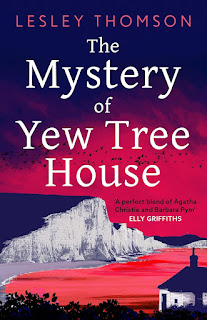I envisaged this as a homage to the Christie/Ngaio Marsh Golden Age, yet with a modern twist. The Mystery of Yew Tree House is set in a dual time frame of 1940 during WWII and the present day. Obviously, I know a bit about now, but to enter the spirit of the forties in wartime Britain – and then to take readers there - required research.
The story was inspired by the many ‘pillboxes’ dotted around the Sussex countryside, where I live. Red-brick structures, square, hexagonal or octagonal, they were built by the coast in the South East and inland at key routes and waterways to defend against a Nazi invasion. Pill boxes were used by the Home Guard – not the jolly bunch of incompetents portrayed in Dad’s Army - but a serious and skilled men with day jobs who had to huddle in these pillboxes every night.
While out with my dog I see many pill boxes. As is often the case, once my attention is caught by a location, in Kew Gardens, the Thames Towpath, I imagine a body there. What if that body was a skeleton dating back to the war?
One joy of writing fiction is research. While an image - say a pillbox – might be a starting point, for me, research is as much an exploration of a subject that’s aroused my curiosity, as about giving ‘reality’ to my fiction.
That adage of ‘write about what you know’ works better as, ‘what I don’t know, I’ll find out then I’ll write about it.’ This has led me out of my study into the world of other people’s chosen paths. I’ve ridden in the cab of a London Underground train listening to the driver describe his work. Exploring behind the scenes of a police station gaining a sense of what it was like to police London in the nineteen-eighties. I’ve interviewed botanists and visited ‘The Artist’s Room’ at Kew gardens to see a botanical illustrator at work. For The Playground Murders, at the Museum of Childhood, I ferreted through yellowing papers describing playground safety in the nineteen-seventies. and eighties. A child of the sixties, I was aghast at ways I could have been injured or worse in my local playground. When I wrote The Companion, I remained in my study to read about psychopaths. I did venture into the cellars at Sheffield Park House where I pondered on where that body might go. Who says writing is a lonely business?
For The Mystery of Yew Tree House, my research involved books on the Home Front, women’s diaries and newspaper archives. But as ever, I tramped the novel’s location . For fictional purposes, Bishopstone and Lindfield became one village.
Delving into the Home Guard I discovered Churchill’s Secret Army. Men – and women – supposedly in the Home Guard, who were actually in an Auxiliary Unit. Trained at a secret location, this guerilla force – called Stay-Behinds –was armed with fearsome a Fairbairn-Sykes dagger with which to ambush a victim and cut his throat. Butcher and bolt. Stay-behinds were in reserved occupations or too young for the forces An ideal recruit knew the terrain, every ditch, every culvert, so could move at night with ease and speed. A blacksmith and farm labourers with practical skills, even poachers. Especially poachers, those used to committed crimes and playing dirty.
I found my neighbour’s father’s name listed in a Sussex Auxiliary Unit. My neighbour had an inkling his dad – a farmworker had not actually been in the Home Guard. Once, his father had pointed towards a field near the farm on where he had worked and remarked, ‘that’s where we were holed up’. That was all. He would have been referring to his unit’s Observational Base, an underground bunker which not even locals knew about. My neighbour said his dad was ‘a gentle giant’, who hated pain or suffering. What had his father made of ‘butcher and bolt’? The Auxiliers were told they had a fortnight before they would be killed.
After the war, cut loose without pensions or praise and, having signed the Official Secrets Act unable to say what they had done in the war. There were medals, but you had to pay for them.
An undercurrent of secrecy and violence lies beneath my ‘cosy’ picture of a village at war. My modern twist on the Golden Age is that nothing is what it seems…
The Mystery of Yew Tree House by Lesley Thomson (Head of Zeus) £20.00 Out Now
Eighty years of secrets. A body that reveals them all. 1940. At Yew Tree House, recently widowed Adelaide Stride is raising her two daughters alone - but it's not just the threat of German invasion that keeps her up at night. She is surrounded by enemies posing as allies and, while war rages, she grows sure that something terrible is about to happen. 2023. Soon after Stella Darnell begins her holiday at Yew Tree House, a skeleton is found in a pillbox at the bottom of the garden. The bullet hole in the skull tells her that the person was murdered. This triggers the unravelling of a mystery eighty years in the making. Soon, Stella will learn that Adelaide was right to worry - the fighting might have been happening abroad, but the true enemy was always much closer to home...
More information about Lesley and her work can be found on her website. You can also find her on X @LesleyjmThomson and on Facebook and on Instagram @lesleythomson.



No comments:
Post a Comment